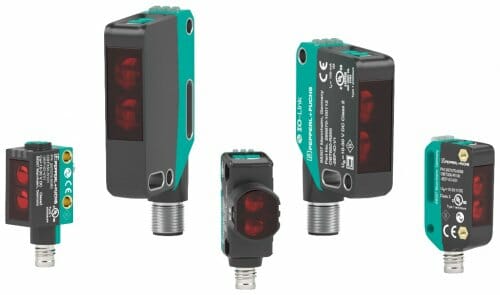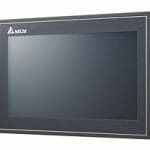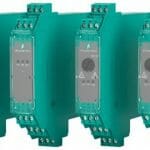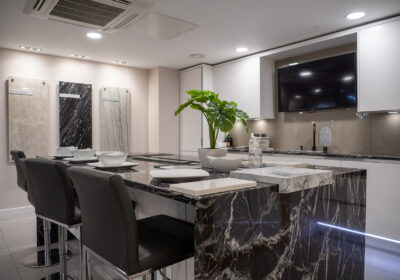Mannheim, April 2018: With the R200 and R201 designs, the forward-thinking product design of photoelectric sensors from Pepperl+Fuchs enables applications with longer operating distances. Just like the compact R100, R101, and R103 series, both new products consistently offer all photoelectric functional principles in a design that is now larger and suitable for specific mounting situations. Usability is intuitive and identical across all series—and the standardized IO-Link connection via the latest Smart Sensor Profiles also enables convenient and reliable integration of the sensors.
The R100-, R101- and R103- with the new R200- and R201 sensors
With the R100, R101, and R103 series, as well as the new R200 and R201 sensors, choosing the relevant sensor is easier and users also benefit from maximum flexibility in every application and mounting situation. In terms of their technical features, the new series also include robust DuraBeam laser technology and high-precision Multi Pixel Technology (MPT) for distance measurement. Standardized usability across all series and functional principles plus the IO-Link interface facilitate parameterization of the sensors during commissioning and when there is a change to the functional principle or to another series.
Identical Functional Principles
The new R200 and R201 series offer all photoelectric functional principles: thru-beam sensors, retroreflective sensors with a polarization filter or for clear object recognition, energetic diffuse mode sensors, sensors with background suppression and foreground suppression, measuring light barriers with two switch points, and distance sensors.
Perfect Usability
All series have an intuitive and identical look and feel during parameterization. Quick and easy sensor adjustment is guaranteed by a multiturn potentiometer and a push button, which function as a combined operating element with three LEDs for visualizing the configuration, status, and diagnostics. Across all series the user benefits from standardized usability: The look and feel when parameterizing a thru-beam sensor, a retroreflective sensor, or a diffuse mode sensor for the R100, R101 or R103 series is the same as for the R200 and R201 designs. This also applies to measuring devices with multiple switch points or distance sensors.
Pepperl+Fuchs is one of the world’s leading providers of industrial sensors and explosion protection. Based on an intense dialogue with our customers for more than 70 years we continue to develop new components and solutions, which support their applications the best way possible. For the landmark topic Industrie 4.0 (Industrial Internet of Things) we develop innovative technologies that pave the way to the digital networked production and to data transfer across all hierarchy levels – even beyond companies’ boundaries.
Industrial sensors: focus on the market
Market-specific solutions dominate an extensive portfolio of industrial sensors that covers all applications the market requires from today’s automation technology. From the inductive and capacitive to the photoelectrical and highly precise ultrasonic sensors, identification systems and many more Pepperl+Fuchs offers all current operating principles in a broad variety.
Sensorik4.0® provides sensor technology for Industrie 4.0. Our technologies enable sensors without difficulty to communicate horizontally within the production process and to exchange data vertically – even into higher-level information systems such as MES or ERP.
Process interfaces: secure applications
Components and technologies for use in hazardous areas are designed to fit the most specific requirements in the industries we serve. They guarantee maximum availability at maximum safety. Isolated barriers, signal isolators, remote I/O or fieldbus systems, HMIs and many other technologies offer solutions for a wide range of applications including certified packaged solutions and all types of explosion protection.
Ex-Protection4.0 brings digital networked Industrie 4.0-production structures to process industries. With concept studies like Ethernet for Process Automation integrated communication throughout all levels of an automation system via Ethernet becomes feasible – for the first time ever even down to the filed level.





